2005 PONTIAC BONNEVILLE fuse
[x] Cancel search: fusePage 262 of 438
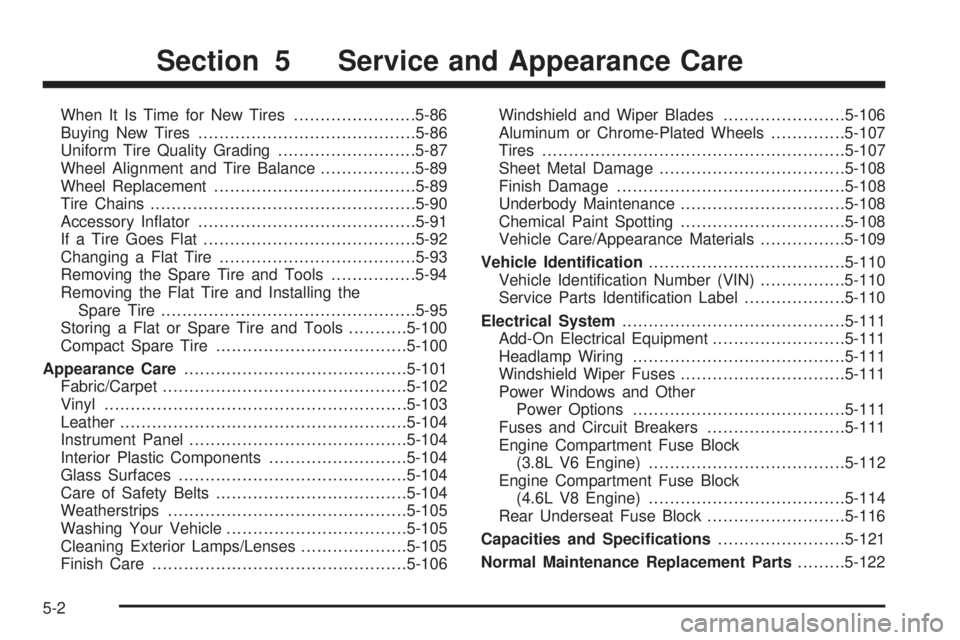
When It Is Time for New Tires.......................5-86
Buying New Tires.........................................5-86
Uniform Tire Quality Grading..........................5-87
Wheel Alignment and Tire Balance..................5-89
Wheel Replacement......................................5-89
Tire Chains..................................................5-90
Accessory In�ator.........................................5-91
If a Tire Goes Flat........................................5-92
Changing a Flat Tire.....................................5-93
Removing the Spare Tire and Tools................5-94
Removing the Flat Tire and Installing the
Spare Tire................................................5-95
Storing a Flat or Spare Tire and Tools...........5-100
Compact Spare Tire....................................5-100
Appearance Care..........................................5-101
Fabric/Carpet..............................................5-102
Vinyl.........................................................5-103
Leather......................................................5-104
Instrument Panel.........................................5-104
Interior Plastic Components..........................5-104
Glass Surfaces...........................................5-104
Care of Safety Belts....................................5-104
Weatherstrips.............................................5-105
Washing Your Vehicle..................................5-105
Cleaning Exterior Lamps/Lenses....................5-105
Finish Care................................................5-106Windshield and Wiper Blades.......................5-106
Aluminum or Chrome-Plated Wheels..............5-107
Tires.........................................................5-107
Sheet Metal Damage...................................5-108
Finish Damage...........................................5-108
Underbody Maintenance...............................5-108
Chemical Paint Spotting...............................5-108
Vehicle Care/Appearance Materials................5-109
Vehicle Identi�cation.....................................5-110
Vehicle Identi�cation Number (VIN)................5-110
Service Parts Identi�cation Label...................5-110
Electrical System..........................................5-111
Add-On Electrical Equipment.........................5-111
Headlamp Wiring........................................5-111
Windshield Wiper Fuses...............................5-111
Power Windows and Other
Power Options........................................5-111
Fuses and Circuit Breakers..........................5-111
Engine Compartment Fuse Block
(3.8L V6 Engine).....................................5-112
Engine Compartment Fuse Block
(4.6L V8 Engine).....................................5-114
Rear Underseat Fuse Block..........................5-116
Capacities and Speci�cations........................5-121
Normal Maintenance Replacement Parts.........5-122
Section 5 Service and Appearance Care
5-2
Page 264 of 438
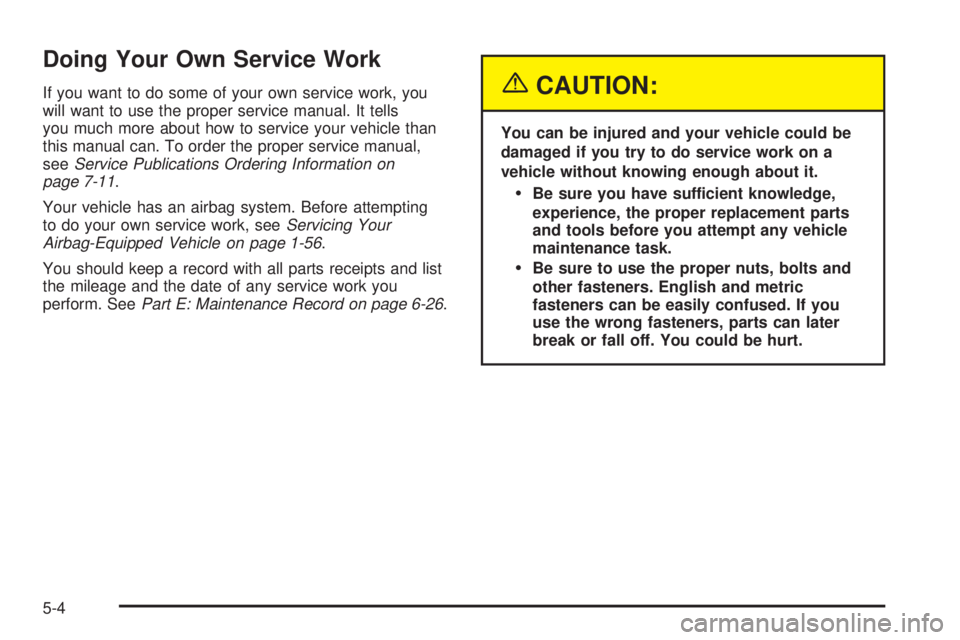
Doing Your Own Service Work
If you want to do some of your own service work, you
will want to use the proper service manual. It tells
you much more about how to service your vehicle than
this manual can. To order the proper service manual,
seeService Publications Ordering Information on
page 7-11.
Your vehicle has an airbag system. Before attempting
to do your own service work, seeServicing Your
Airbag-Equipped Vehicle on page 1-56.
You should keep a record with all parts receipts and list
the mileage and the date of any service work you
perform. SeePart E: Maintenance Record on page 6-26.{CAUTION:
You can be injured and your vehicle could be
damaged if you try to do service work on a
vehicle without knowing enough about it.
Be sure you have sufficient knowledge,
experience, the proper replacement parts
and tools before you attempt any vehicle
maintenance task.
Be sure to use the proper nuts, bolts and
other fasteners. English and metric
fasteners can be easily confused. If you
use the wrong fasteners, parts can later
break or fall off. You could be hurt.
5-4
Page 273 of 438
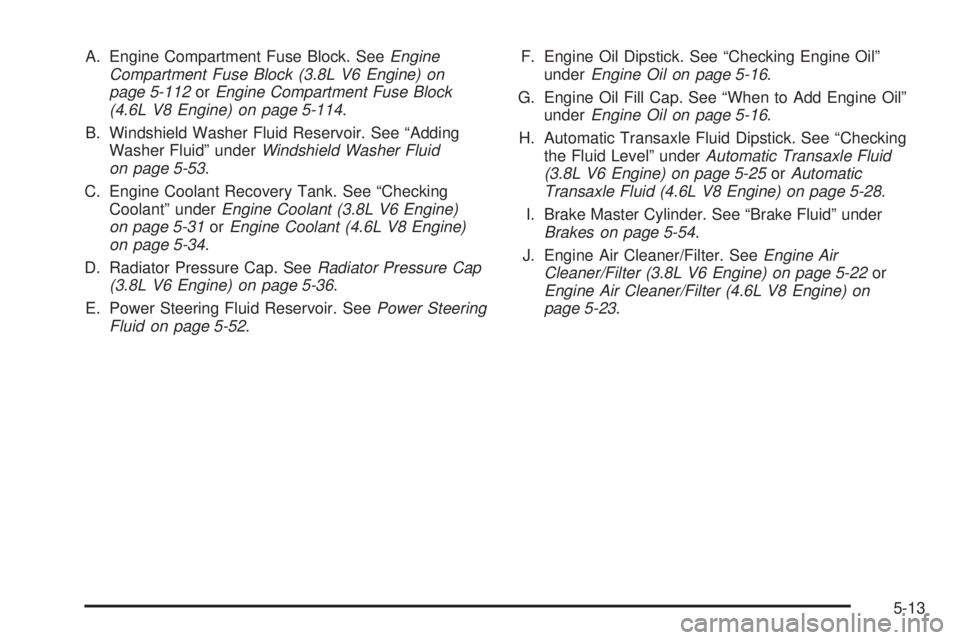
A. Engine Compartment Fuse Block. SeeEngine
Compartment Fuse Block (3.8L V6 Engine) on
page 5-112orEngine Compartment Fuse Block
(4.6L V8 Engine) on page 5-114.
B. Windshield Washer Fluid Reservoir. See “Adding
Washer Fluid” underWindshield Washer Fluid
on page 5-53.
C. Engine Coolant Recovery Tank. See “Checking
Coolant” underEngine Coolant (3.8L V6 Engine)
on page 5-31orEngine Coolant (4.6L V8 Engine)
on page 5-34.
D. Radiator Pressure Cap. SeeRadiator Pressure Cap
(3.8L V6 Engine) on page 5-36.
E. Power Steering Fluid Reservoir. SeePower Steering
Fluid on page 5-52.F. Engine Oil Dipstick. See “Checking Engine Oil”
underEngine Oil on page 5-16.
G. Engine Oil Fill Cap. See “When to Add Engine Oil”
underEngine Oil on page 5-16.
H. Automatic Transaxle Fluid Dipstick. See “Checking
the Fluid Level” underAutomatic Transaxle Fluid
(3.8L V6 Engine) on page 5-25orAutomatic
Transaxle Fluid (4.6L V8 Engine) on page 5-28.
I. Brake Master Cylinder. See “Brake Fluid” under
Brakes on page 5-54.
J. Engine Air Cleaner/Filter. SeeEngine Air
Cleaner/Filter (3.8L V6 Engine) on page 5-22or
Engine Air Cleaner/Filter (4.6L V8 Engine) on
page 5-23.
5-13
Page 275 of 438
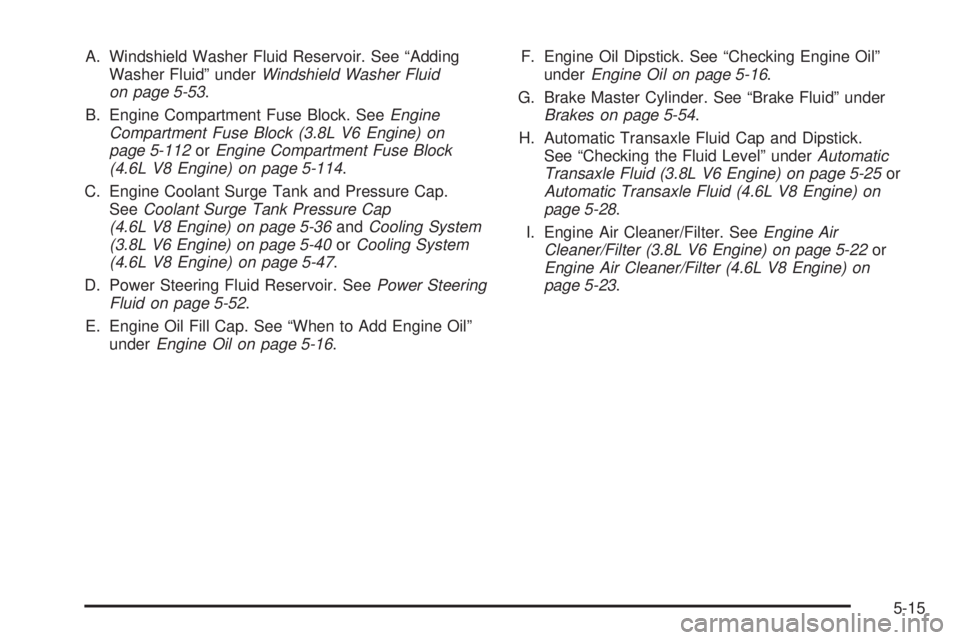
A. Windshield Washer Fluid Reservoir. See “Adding
Washer Fluid” underWindshield Washer Fluid
on page 5-53.
B. Engine Compartment Fuse Block. SeeEngine
Compartment Fuse Block (3.8L V6 Engine) on
page 5-112orEngine Compartment Fuse Block
(4.6L V8 Engine) on page 5-114.
C. Engine Coolant Surge Tank and Pressure Cap.
SeeCoolant Surge Tank Pressure Cap
(4.6L V8 Engine) on page 5-36andCooling System
(3.8L V6 Engine) on page 5-40orCooling System
(4.6L V8 Engine) on page 5-47.
D. Power Steering Fluid Reservoir. SeePower Steering
Fluid on page 5-52.
E. Engine Oil Fill Cap. See “When to Add Engine Oil”
underEngine Oil on page 5-16.F. Engine Oil Dipstick. See “Checking Engine Oil”
underEngine Oil on page 5-16.
G. Brake Master Cylinder. See “Brake Fluid” under
Brakes on page 5-54.
H. Automatic Transaxle Fluid Cap and Dipstick.
See “Checking the Fluid Level” underAutomatic
Transaxle Fluid (3.8L V6 Engine) on page 5-25or
Automatic Transaxle Fluid (4.6L V8 Engine) on
page 5-28.
I. Engine Air Cleaner/Filter. SeeEngine Air
Cleaner/Filter (3.8L V6 Engine) on page 5-22or
Engine Air Cleaner/Filter (4.6L V8 Engine) on
page 5-23.
5-15
Page 317 of 438
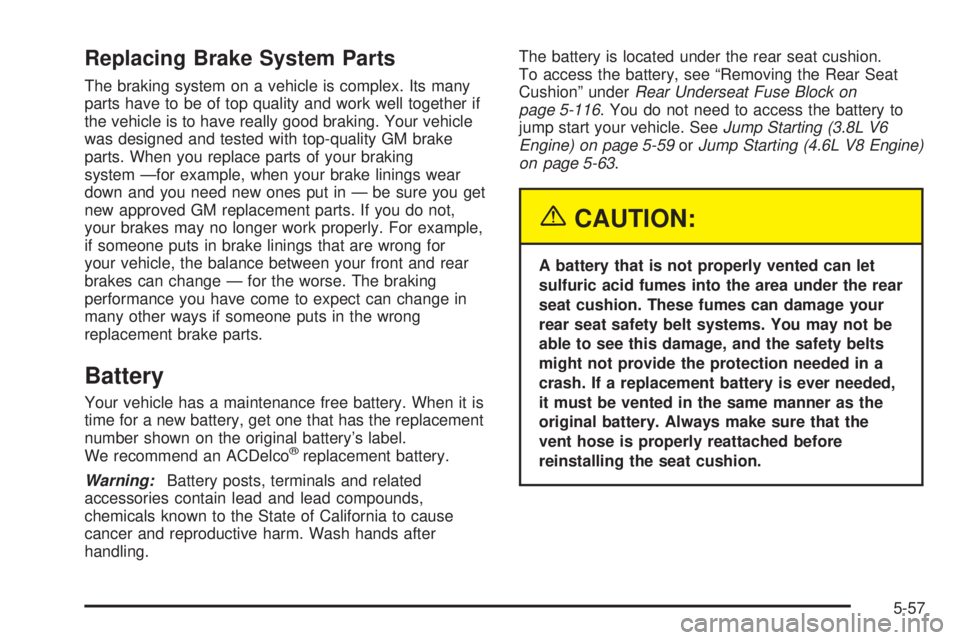
Replacing Brake System Parts
The braking system on a vehicle is complex. Its many
parts have to be of top quality and work well together if
the vehicle is to have really good braking. Your vehicle
was designed and tested with top-quality GM brake
parts. When you replace parts of your braking
system —for example, when your brake linings wear
down and you need new ones put in — be sure you get
new approved GM replacement parts. If you do not,
your brakes may no longer work properly. For example,
if someone puts in brake linings that are wrong for
your vehicle, the balance between your front and rear
brakes can change — for the worse. The braking
performance you have come to expect can change in
many other ways if someone puts in the wrong
replacement brake parts.
Battery
Your vehicle has a maintenance free battery. When it is
time for a new battery, get one that has the replacement
number shown on the original battery’s label.
We recommend an ACDelco
®replacement battery.
Warning:Battery posts, terminals and related
accessories contain lead and lead compounds,
chemicals known to the State of California to cause
cancer and reproductive harm. Wash hands after
handling.The battery is located under the rear seat cushion.
To access the battery, see “Removing the Rear Seat
Cushion” underRear Underseat Fuse Block on
page 5-116. You do not need to access the battery to
jump start your vehicle. SeeJump Starting (3.8L V6
Engine) on page 5-59orJump Starting (4.6L V8 Engine)
on page 5-63.
{CAUTION:
A battery that is not properly vented can let
sulfuric acid fumes into the area under the rear
seat cushion. These fumes can damage your
rear seat safety belt systems. You may not be
able to see this damage, and the safety belts
might not provide the protection needed in a
crash. If a replacement battery is ever needed,
it must be vented in the same manner as the
original battery. Always make sure that the
vent hose is properly reattached before
reinstalling the seat cushion.
5-57
Page 371 of 438
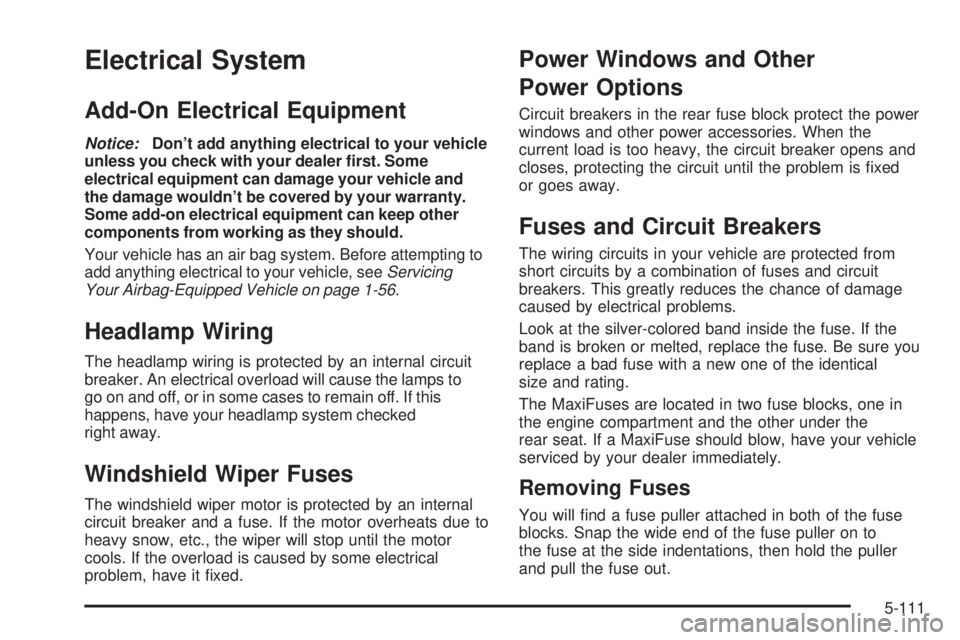
Electrical System
Add-On Electrical Equipment
Notice:Don’t add anything electrical to your vehicle
unless you check with your dealer �rst. Some
electrical equipment can damage your vehicle and
the damage wouldn’t be covered by your warranty.
Some add-on electrical equipment can keep other
components from working as they should.
Your vehicle has an air bag system. Before attempting to
add anything electrical to your vehicle, seeServicing
Your Airbag-Equipped Vehicle on page 1-56.
Headlamp Wiring
The headlamp wiring is protected by an internal circuit
breaker. An electrical overload will cause the lamps to
go on and off, or in some cases to remain off. If this
happens, have your headlamp system checked
right away.
Windshield Wiper Fuses
The windshield wiper motor is protected by an internal
circuit breaker and a fuse. If the motor overheats due to
heavy snow, etc., the wiper will stop until the motor
cools. If the overload is caused by some electrical
problem, have it �xed.
Power Windows and Other
Power Options
Circuit breakers in the rear fuse block protect the power
windows and other power accessories. When the
current load is too heavy, the circuit breaker opens and
closes, protecting the circuit until the problem is �xed
or goes away.
Fuses and Circuit Breakers
The wiring circuits in your vehicle are protected from
short circuits by a combination of fuses and circuit
breakers. This greatly reduces the chance of damage
caused by electrical problems.
Look at the silver-colored band inside the fuse. If the
band is broken or melted, replace the fuse. Be sure you
replace a bad fuse with a new one of the identical
size and rating.
The MaxiFuses are located in two fuse blocks, one in
the engine compartment and the other under the
rear seat. If a MaxiFuse should blow, have your vehicle
serviced by your dealer immediately.
Removing Fuses
You will �nd a fuse puller attached in both of the fuse
blocks. Snap the wide end of the fuse puller on to
the fuse at the side indentations, then hold the puller
and pull the fuse out.
5-111
Page 372 of 438
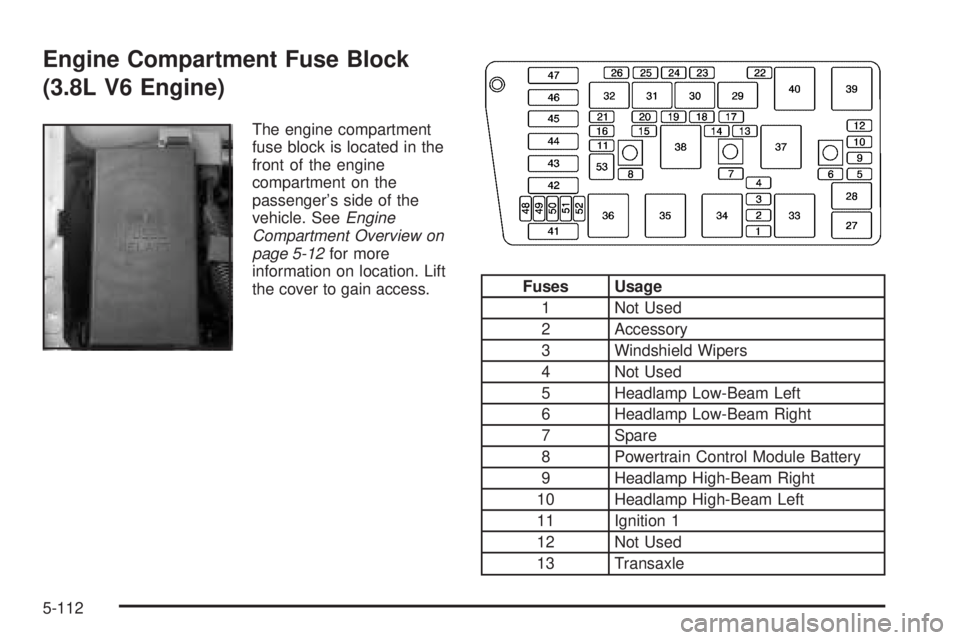
Engine Compartment Fuse Block
(3.8L V6 Engine)
The engine compartment
fuse block is located in the
front of the engine
compartment on the
passenger’s side of the
vehicle. SeeEngine
Compartment Overview on
page 5-12for more
information on location. Lift
the cover to gain access.
Fuses Usage
1 Not Used
2 Accessory
3 Windshield Wipers
4 Not Used
5 Headlamp Low-Beam Left
6 Headlamp Low-Beam Right
7 Spare
8 Powertrain Control Module Battery
9 Headlamp High-Beam Right
10 Headlamp High-Beam Left
11 Ignition 1
12 Not Used
13 Transaxle
5-112
Page 373 of 438
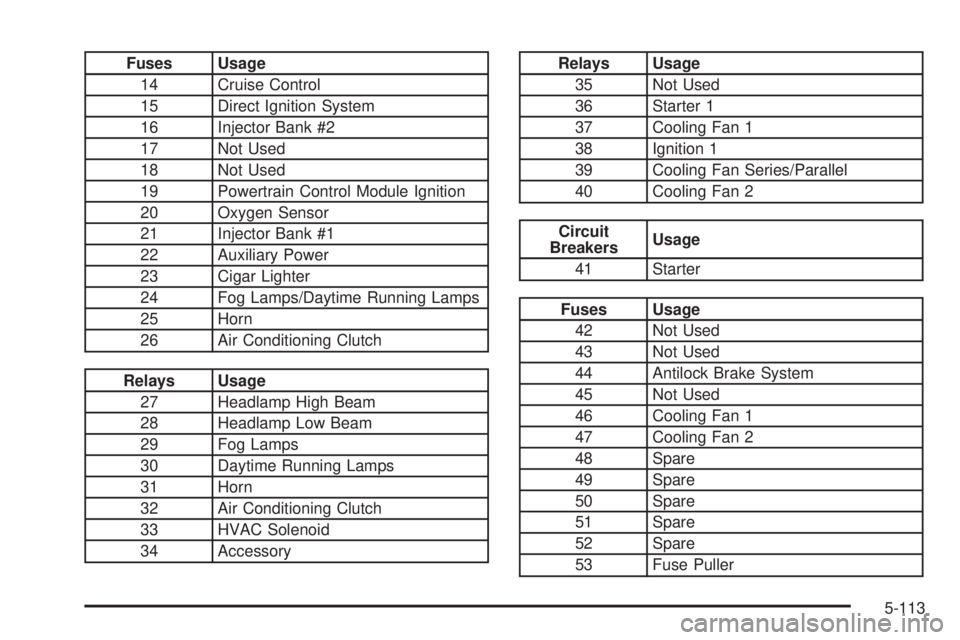
Fuses Usage
14 Cruise Control
15 Direct Ignition System
16 Injector Bank #2
17 Not Used
18 Not Used
19 Powertrain Control Module Ignition
20 Oxygen Sensor
21 Injector Bank #1
22 Auxiliary Power
23 Cigar Lighter
24 Fog Lamps/Daytime Running Lamps
25 Horn
26 Air Conditioning Clutch
Relays Usage
27 Headlamp High Beam
28 Headlamp Low Beam
29 Fog Lamps
30 Daytime Running Lamps
31 Horn
32 Air Conditioning Clutch
33 HVAC Solenoid
34 Accessory
Relays Usage
35 Not Used
36 Starter 1
37 Cooling Fan 1
38 Ignition 1
39 Cooling Fan Series/Parallel
40 Cooling Fan 2
Circuit
BreakersUsage
41 Starter
Fuses Usage
42 Not Used
43 Not Used
44 Antilock Brake System
45 Not Used
46 Cooling Fan 1
47 Cooling Fan 2
48 Spare
49 Spare
50 Spare
51 Spare
52 Spare
53 Fuse Puller
5-113